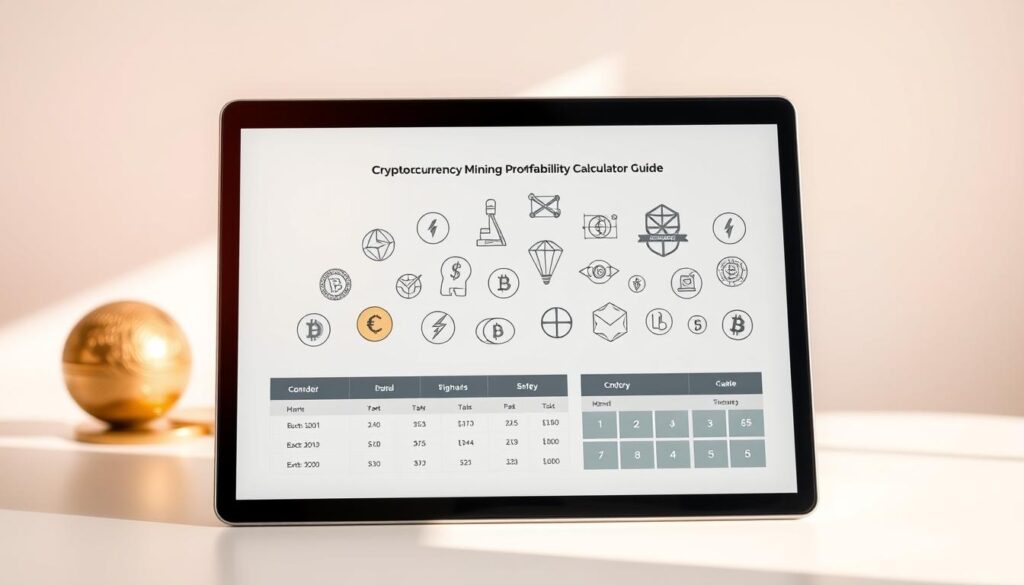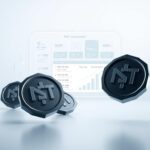Now Reading: Cryptocurrency Mining Profitability Calculator2026 for Miners
- 01
Cryptocurrency Mining Profitability Calculator2026 for Miners
Cryptocurrency Mining Profitability Calculator2026 for Miners
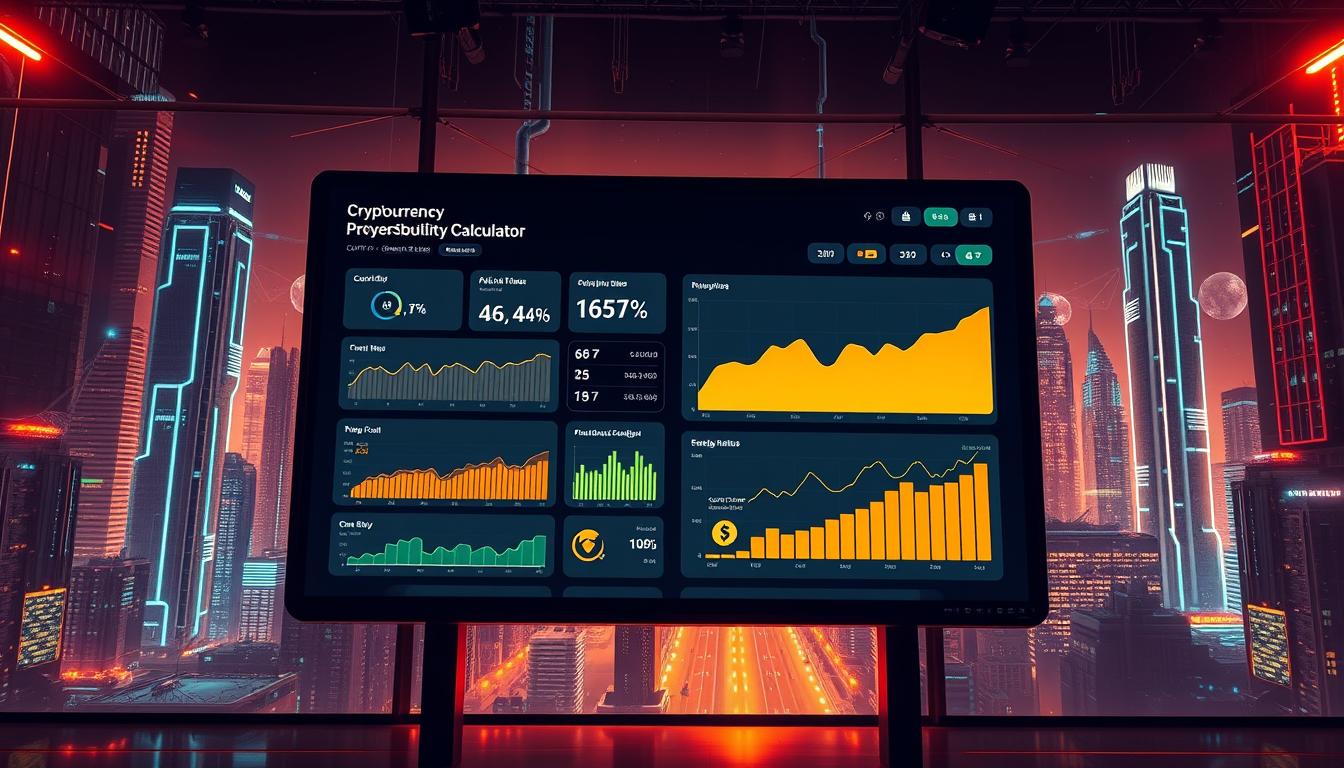
Plan for 2026 now. This guide shows miners how to model future returns and make smarter investment choices. You will learn which inputs matter most and how to read realistic per day bitcoin profit projections.
We start with a real example: a MicroBT Whatsminer M63S Hydro 390T at 7,215 W and $0.05 per kWh. At a BTC price near $109,360 and difficulty ~142.34T, daily revenue is $18.84, energy costs $8.66, for $10.18 bitcoin profit per day.
The calculator synthesizes hashrate, power draw, electricity costs, block reward (3.125 BTC) and price to give clear outputs. This snapshot uses network hashrate ~1,083.97 EH/s and a 10-minute block time.
What you’ll get: step-by-step workflow from selecting mining hardware and entering th/s and watts, to comparing price scenarios and optimizing costs. Use the model to decide when to buy asic units, secure energy, and balance capex vs opex.
Why 2026 Profitability Modeling Matters After the 2024 Halving
The 2024 halving reduced block rewards to 3.125 BTC, tightening margins and making energy and efficiency the main levers for survival. Operators now need clear, year-long scenario planning to test how price and difficulty shifts affect returns.
Modeling over a year reveals risk. As large U.S. firms expand and new entrants add hashrate, difficulty can rise and dilute individual output unless hardware or power strategy keeps pace.
Price bands like $70k–$90k interact with difficulty to create wide swings in net revenue. That makes tested scenarios essential before you buy or scale.

- Energy strategy: long-term contracts and renewables can stabilize costs.
- Regulatory timing: local rules on grid access and emissions affect deployment schedules.
- Operational buffers: plan for difficulty increases and power constraints.
| Factor | 2024–25 Trend | Action | Impact |
|---|---|---|---|
| Rewards | 3.125 BTC per block | Prioritize efficient ASICs | Protect margins |
| Hashrate | ~900+ EH/s growth | Model difficulty scenarios | Avoid diluted returns |
| Energy mix | ~52% renewables, gas ~38% | Negotiate long contracts | Stabilize $/kWh |
How a Bitcoin and cryptocurrency mining calculator works
Core idea: the formula turns your th/s and power into an expected BTC share of blocks, then converts that to USD using the bitcoin price.

Core formula
The model computes your share of network hashrate and multiplies it by block reward and block frequency. With a fixed 3.125 BTC reward and current difficulty, it yields BTC earned per hour, day, week, month, and year.
What inputs and outputs mean
You control hashrate, power (watts), and electricity costs. External inputs include network difficulty and btc price.
- Outputs: revenue in USD, electricity costs per day, pool fees impact, and net profit per day/week/month/year.
- Example: A MicroBT Whatsminer M63S Hydro (390 th/s, 7,215 W) at $0.05/kWh produces ~$18.84 revenue, $8.66 energy, and $10.18 profit per day.
Limitations
Results change with difficulty retargets, BTC price swings, stale shares, pool luck, and downtime. Always export scenarios and use a chart of projected cash flows before you buy equipment.
| Input | Sample Value | Output |
|---|---|---|
| TH/s | 390 | 0.00017224 BTC/day (~$18.84) |
| Power (W) | 7,215 | $8.66/day energy |
| Pool fees | 1%–4% | Reduces net USD and BTC amounts |
Gather your inputs: hardware, power, and costs for accurate results
Accurate inputs begin with clear hardware specs and a real electricity profile for your site. Collecting precise values ensures your model reflects true operating conditions and avoids surprises when you scale.
ASIC specs to record:
- th/s, watts, J/TH, MSRP (USD), and cooling type (air, immersion, hydro).
- Example rigs: Antminer S21 (200 th/s, 3,500 W), Whatsminer M60S (186 th/s, 3,441 W), Whatsminer M63S Hydro (390 th/s, 7,215 W), Antminer S21 Hydro (335 th/s, 5,360 W).
Energy profile and power capacity:
- Document your per kwh rate, on/off-peak tiers, and site cooling options.
- Compute capacity: AMPS × volts (e.g., 200 A × 220 V = 44,000 W). Use 75% (≈33,000 W) as a safety margin to estimate how many miners you can run without tripping breakers.
Operational variables to include: pool/maintenance fees (1%–4%), uptime targets, facility rent, internet, warranty and expected maintenance so results map to full costs, not just watts and hashrate.
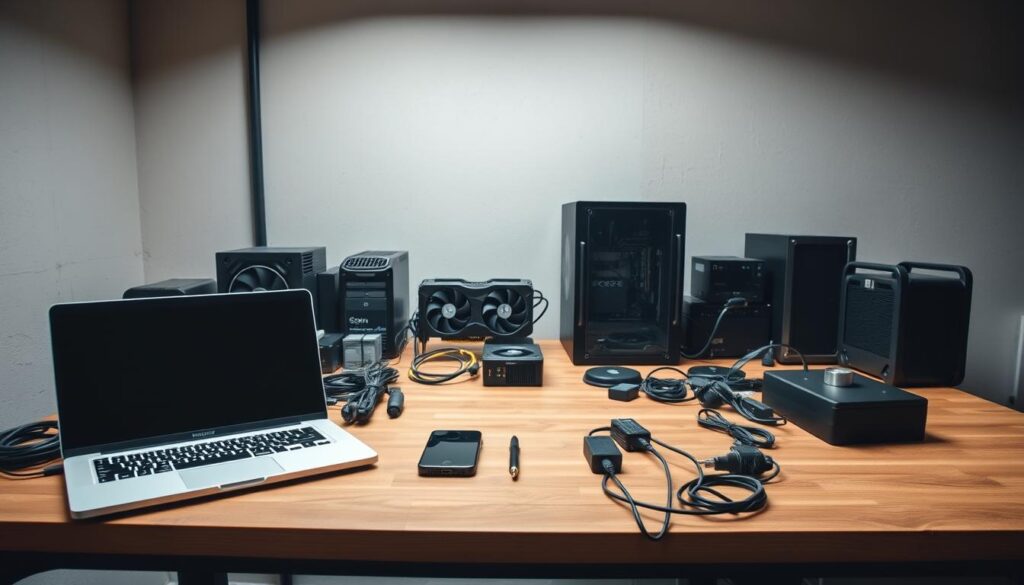
| Model | th/s | Power (W) | MSRP (USD) |
|---|---|---|---|
| Whatsminer M63S Hydro | 390 | 7,215 | $13,699 |
| Antminer S21 | 200 | 3,500 | $5,449 |
| Whatsminer M60S | 186 | 3,441 | $6,299 |
| Antminer S21 Hydro | 335 | 5,360 | $7,599 |
Step-by-step: use a BTC mining calculator to estimate profits today
Run a live test by preloading a real rig profile and your site power price. That gives immediate visibility into daily and longer-term returns.
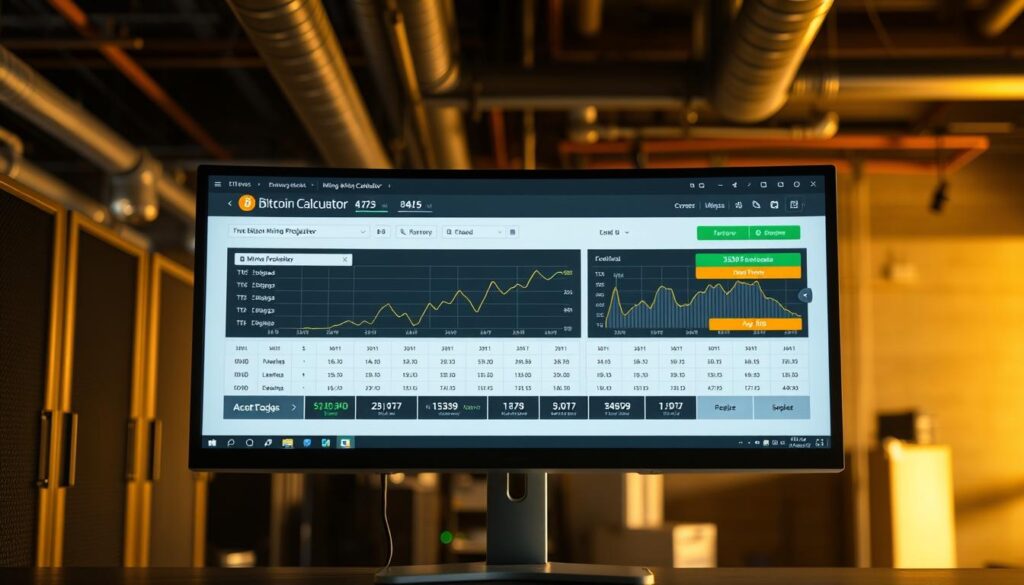
Preload a miner
Example: select the Whatsminer M63S Hydro with 390 th/s and 7,215 W, then enter $0.05 per kwh.
Read the outputs
| Metric | Value | Notes |
|---|---|---|
| Mining Revenue | $18.84 per day | USD at BTC ≈ $109,360 |
| Electricity Costs | $8.66 per day | 7,215 W at $0.05/kwh |
| Net profit | $10.18 per day | 0% pool fees in this example |
| BTC per day | 0.00017224 BTC | Hourly 0.00000718 BTC |
Cross-check and adjust
Toggle pool fees (1%–4%), add hardware cost, and run sensitivity tests by nudging BTC price or difficulty. This shows ROI, payback amount, and how fast profit can shift.
- Preload alternative rigs (e.g., Whatsminer M60S) to compare hashrate and watts before you buy.
- Record outputs per day and per kwh to benchmark performance after deployment.
- For a quick external reference, try the crypto profit tool to cross-validate results.
cryptocurrency mining profitability calculator 2026: forecast scenarios you should test
Simulate $70k, $90k, and $110k+ price trajectories to quantify exposure and capital needs for the coming year.
Price paths: run three cases — conservative ($70k), base ($90k), and upside ($110k+) — and export monthly and annual outputs. Compare USD and BTC results so you see both fiat cash flow and cumulative BTC holdings.
Difficulty and hashrate sensitivity
Model network hashrate bands around 900–1,080 EH/s to reflect expected expansion. Small changes in hashrate reduce your share of rewards unless you add th/s.
Block reward planning
Keep the block reward fixed at 3.125 BTC in all runs. Use a chart of forecasted earnings to visualize cumulative divergence between scenarios over the year.
| Scenario | BTC price | Hashrate band | Key export |
|---|---|---|---|
| Conservative | $70,000 | 900 EH/s | Monthly cashflow, breakeven kWh |
| Base | $90,000 | ~1,000 EH/s | ROI months, USD and BTC outputs |
| Upside | $110,000+ | 1,080 EH/s | Working capital and scaling triggers |
- Pair price and difficulty moves to avoid optimistic bias; price gains often draw new hashrate.
- Stress-test power and costs: bump $/kWh a few cents to see margin erosion.
- Document trigger levels (minimum net per rig) to decide when to pause, scale, or buy.
Choosing miners for 2026: efficiency, hashrate, and total cost of ownership
Selecting the right hardware means weighing efficiency, warranty, and resale alongside headline th/s figures. This approach keeps operational surprises low and helps you match rigs to site limits.
Sub-17 J/TH targets and examples
Efficiency matters first: aim for sub-17 J/TH units to cut per‑TH power draw and protect margins if hashrate grows.
- Antminer S21 — 200 th/s at 3,500 W (MSRP $5,449)
- Antminer S21 Hydro — 335 th/s at 5,360 W (MSRP $7,599)
- Whatsminer M60S — 186 th/s at 3,441 W (MSRP $6,299)
- Whatsminer M63S Hydro — 390 th/s at 7,215 W (MSRP $13,699)
Capex vs. opex tradeoffs
Model both initial buy price and ongoing electricity and service costs before you buy.
Slightly cheaper asic units with worse efficiency often raise annual costs and hurt long‑term profitability.
| Model | th/s | Power (W) | MSRP (USD) | Cooling |
|---|---|---|---|---|
| Antminer S21 | 200 | 3,500 | $5,449 | Air |
| S21 Hydro | 335 | 5,360 | $7,599 | Hydro |
| Whatsminer M60S | 186 | 3,441 | $6,299 | Air |
| M63S Hydro | 390 | 7,215 | $13,699 | Hydro |
Factor in resale value, warranty, and firmware support. These affect uptime, service costs, and how fast you can refresh hardware to chase BTC price moves.
Electricity strategy: reducing $/kWh to protect bitcoin profit
Securing cheap, reliable power changes the economics of every rig you run. Start by prioritizing energy deals that cut your per kwh rate—hydro and wind PPAs or long-term contracts offer the deepest structural advantage.
Energy sourcing and cooling
Hydro and wind sites often deliver $0.04–$0.06 per kwh in the best U.S. markets. Where grid rates exceed $0.30, those deals are decisive.
Consider immersion or hydro cooling to lower kWh/W and raise density. This reduces fan load and can cut total power draw for the same hashrate.
Competing for capacity
AI data centers now compete for power. Negotiate firm capacity allocations and explore dual‑use agreements to keep utilization steady and fees predictable.
Regulatory and fee risks
Account for demand charges, interconnection fees, and curtailment clauses when modeling costs.
In the U.S., plan for emissions reporting, noise limits, and grid access rules. Build compliance into site design to avoid shutdowns or delays.
| Option | Typical $/kWh | Benefit | Notes |
|---|---|---|---|
| Hydro PPA | $0.04–$0.06 | Lowest steady cost | Best for long‑term bitcoin mining sites |
| Wind PPA | $0.05–$0.07 | Stable renewables mix | Seasonal variability; pair with storage |
| Behind‑meter / stranded gas | $0.03–$0.08 | Flexible capacity | Requires capex and local permits |
Interpreting calculator results: margin, risk, and ROI in USD and BTC
Start by building a margin stack that separates gross revenue, electricity, pool fees, and other costs. This shows per day profit for each rig and makes risk visible.
Example: a 390 th/s rig at $0.05/kWh produces $18.84 revenue, $8.66 energy, and $10.18 net per day before fees. Add a 1%–4% pool fee and maintenance to see the true bitcoin profit in USD and BTC.
Profitability thresholds: breakeven kWh, fees, and uptime
Calculate your breakeven kwh by solving for the $/kWh that makes net = 0 after fees. Small fee changes matter: a single percent can reduce monthly bitcoin profit noticeably.
Always include uptime assumptions. Factor in scheduled maintenance, potential curtailment, and a safety margin for power capacity (use the 75% rule for AMPS × volts).
From daily profit per miner to portfolio planning
Scale per miner results by the number of units to test facility limits. Multiply the $10.18 net per day by many miners to get total USD cash flow and the BTC amount produced daily, weekly, and annually.
- Capacity check: ensure your power capacity supports the planned th/s without exceeding the 75% safe load.
- Scenario tests: rerun ROI with higher kwh, added fees, and modest hashrate degradation to avoid over‑optimistic forecasts.
- Reserve strategy: track BTC amount vs USD revenue for tax and treasury planning.
| Metric | Per Rig | Portfolio (10 rigs) |
|---|---|---|
| Revenue per day | $18.84 | $188.40 |
| Electricity per day | $8.66 | $86.60 |
| Net per day (before fees) | $10.18 | $101.80 |
Re-run ROI monthly with updated costs, fees, and kwh rates. Monitor th/s and hashrate for degradation so you can protect long‑term investment returns.
Turning insights into a 2026 action plan
Build a stepwise strategy that secures long‑term energy, times ASIC buys, and sizes capacity to cashflow.
Start by locking power — long contracts or hydro PPAs cut kwh exposure and make buy decisions predictable.
Lock in energy, refresh ASICs, and plan difficulty buffers
Secure firm energy deals before you buy hardware. That reduces exposure to volatile costs and keeps per‑rig economics stable.
Schedule ASIC refreshes to stay under target J/TH. Aim for sub‑15–17 J/TH units so your th/s remains competitive as hashrate rises.
Model difficulty buffers in every investment case. Require a minimum net per rig under downside price and upside hashrate scenarios.
Hybrid strategies: AI hosting, waste‑heat recovery, and BTC reserve management
Explore hybrid revenue: lease spare capacity to AI tenants or sell waste heat to local users. These tactics lower operating costs and diversify income.
Adopt treasury rules: mine bitcoin and hold a reserve to smooth cashflow. Convert only what your model shows you need for capex and operating costs.
| Action | Why it matters | Immediate step |
|---|---|---|
| Lock energy | Stabilizes kwh and lowers costs | Negotiate hydro or long PPA |
| Stagger ASIC buys | Limits capex risk and keeps th/s fresh | Set refresh cadence every 12–24 months |
| Hybrid revenue | Diversifies cash and reduces net costs | Pilot AI hosting or heat sales |
| Treasury policy | Buffers price swings | Define BTC reserve % and sell triggers |
Conclusion
Use charted scenarios to turn raw numbers into a defendable purchase and power plan. With a 390 th/s rig at 7,215 W and $0.05/kWh, the model shows roughly $10.18 per day at BTC ≈ $109,360 and difficulty ~142.34T. The block reward stays at 3.125 BTC with 10‑minute blocks.
Disciplined modeling — updating btc, bitcoin price, and difficulty — makes uncertain markets actionable. Track th/s, watts, and site capacity so you scale inside power and cooling limits and protect profit in USD and BTC.
Prioritize energy deals (hydro or long contracts), chart outputs regularly, and calculate bitcoin scenarios before you buy more rigs. Align tools, live data, and strategy to position your bitcoin mining operation for durable rewards.
FAQ
What inputs do I need to estimate BTC returns with a mining calculator?
You need your miner’s hashrate (TH/s), power draw (watts), and efficiency (J/TH), plus the current BTC/USD price, network difficulty or total hashrate, block reward (3.125 BTC after the 2024 halving), pool fees, and your electricity cost ($/kWh). Add uptime, cooling method, and any facility or maintenance costs for a realistic result.
How does the core formula work to convert hashrate into expected BTC revenue?
The calculator estimates your share of the network by dividing your hashrate by the total network hashrate, then multiplies that share by blocks mined per time period and the block reward (3.125 BTC). It converts BTC to USD using the BTC price and subtracts electricity, fees, and other costs to get net profit per day, month, or year.
Which ASIC models should I enter for accurate 2026 planning?
Include real models and their specs: Antminer S21 or S21 Hydro, Whatsminer M60S, M63 series, and other sub-17 J/TH units. Enter each unit’s TH/s, watts, and MSRP so you can compare revenue, power draw, and payback. Also model immersion or hydro-cooled versions if you use them.
How do electricity costs and power capacity affect my returns?
Electricity price ($/kWh) is often the largest operating expense. Lower kWh rates directly increase margins. Power capacity (amps × volts) and cooling method determine how many units you can host and the cost of additional infrastructure. Long-term contracts, hydro or wind power, and immersion cooling reduce effective kWh and boost profit.
What limitations should I expect from results a calculator provides?
Calculators assume static difficulty and price, but both change. They don’t fully capture pool luck, stale shares, or downtime. Results are estimates — use sensitivity tests for price paths, difficulty growth, and uptime to see a range of outcomes rather than a single number.
How should I model BTC price and difficulty for 2026 scenarios?
Run multiple price paths (for example k, k, 0k+) and difficulty/total hashrate scenarios (near 900–1,080 EH/s or higher). Combine optimistic and conservative cases to see margin sensitivity. Keep the block reward fixed at 3.125 BTC for short-term forecasts to the next halving window.
How do I calculate breakeven kWh and payback period?
Breakeven kWh is the electricity price at which revenue equals operating costs for a given miner and BTC price. Payback period equals initial hardware and setup cost divided by net profit per period. Adjust for pool fees, warranty, and expected uptime to get realistic ROI timing.
Can I model many miners or a fleet in the same estimate?
Yes — sum the fleet’s total TH/s and total power draw, then enter aggregate costs and fees. Include facility limits like power capacity, rack space, and cooling. Modeling by fleet helps test scale effects, capex vs. opex tradeoffs, and portfolio-level ROI.
How do cooling choices like immersion or hydro units change results?
Immersion and hydro cooling typically improve thermal efficiency and can reduce overhead for HVAC, lowering effective kWh/W and enabling higher density per rack. Account for higher capex and potential maintenance savings when comparing to air-cooled setups.
What operational variables should I include beyond electricity and hardware?
Include pool and maintenance fees, expected uptime, repair and spare-parts costs, facility rent or buildout, insurance, and any taxes or regulatory compliance expenses (e.g., emissions reporting). These impact net profit and payback.
How often should I update inputs in a profitability model?
Update BTC price and network difficulty daily or weekly if you actively trade forecasts. Revise electricity contracts, fleet counts, and hardware specs when you add or retire units. Regular sensitivity checks ensure plans remain robust to market moves.
Are there alternative revenue strategies I should test alongside ASIC hosting?
Yes — consider hybrid strategies like AI hosting or colocation that sell compute or heat reuse, waste-heat recovery for facility offset, and holding BTC reserves rather than converting all receipts to USD. These can change effective margins and risk profiles.
Which fees and hidden costs often surprise new operators?
Hidden costs include transformer and distribution upgrades, demand charges on commercial power bills, customs and shipping for imported miners, extended warranty or repair expenses, and downtime from maintenance. Factor these to avoid overstated profits.
How do pool fees and pool luck affect short-term income?
Pool fees are a direct subtraction from gross revenue. Pool luck affects variance — solo or small-pool miners see wider swings, while large pools smooth income. Use monthly or annualized averages to understand expected returns, not single-day results.
What are practical steps to lower $/kWh and protect margins?
Negotiate long-term power purchase agreements, locate near low-cost hydro or wind resources, invest in immersion cooling to increase density and reduce HVAC loads, and explore demand-response programs. Energy sourcing and contracts are as important as hardware efficiency.
How do I convert daily BTC revenue to USD and track performance?
Multiply estimated BTC earnings by your chosen BTC/USD price for the period to get USD revenue. Subtract electricity, fees, and other operating costs to track daily net profit. Keep a ledger in both BTC and USD to measure real performance and hedge risk.
When choosing between miners, what metrics matter most for 2026?
Prioritize efficiency (J/TH), price per TH (capex), warranty/reliability, resale value, and integration costs (rack, power). Sub-17 J/TH models like Antminer S21 series and Whatsminer M60S/M63 offer strong efficiency, but evaluate total cost of ownership.
How should I account for regulatory and grid constraints in the U.S.?
Check local interconnection rules, emissions reporting, noise ordinances, and permitting timelines. Grid constraints and demand charges can increase costs or limit expansion. Plan for compliance expenses and potential curtailment risk in your model.


